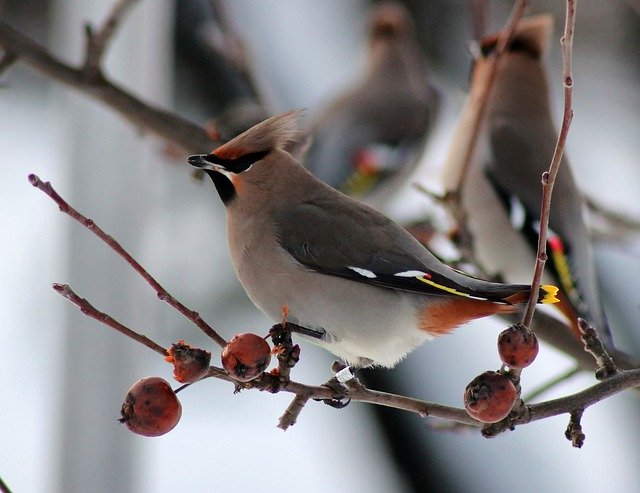The Evolution of Getting Drunk
Oh boy! The poor fella in the video got drunk from eating fermented crabapples (genus Malus). We wouldn't get drunk from that amount, of course - we need more alcohol to make us behave that strange. Have you ever wondered why that is?
To find out, we need to go back some 10 million years, a group of scientists from the Foundation for Applied Molecular Evolution in Gainesville, Florida, and Indiana University suggests.
They conducted a study that allows us to look at contemporary diseases from an evolutionary perspective - if an organism is adapted to a certain kind of diet, it should not become diseased by consuming it. Just as consuming sugars in high doses leads to diabetes, obesity and high blood pressure, consuming alcohol leads to a problem as well - alcoholism.
Matthew Carrigan and his colleagues used paleogenetics to find out whether ethanol became a part of hominin diet only after humans started with food storing and learned to intentionally direct food fermentation, or whether ethanol was already part of primate diet in the time of primate diversification (ca. 77 million years ago). The latter model comes with two explanations as to how primates adapted to ingesting ethanol.
First we could understand consuming alcohol as what Robert Dudley called an "evolutionary hangover" - our primate ancestors were attracted to mildly fermented fruits (a source of various nutrients) and this attraction lost its benefit when humans redirected this attraction to beverages that have a much higher concentration of ethanol once they learned how to make them. The second explanation posits that ethanol itself could be a valuable source and that the ability to metabolize it opened a new ecological niche that could not be exploited by those who don't posses that ability. This means that primates that evolved a way to metabolize ethanol could eat fermented fruit which were left uneaten by other animals, so they did not have to compete for it with many other species.
To get closer to a valid theory, the team sequenced ADH4 proteins from 19 primates. ADH4 is a class of alcohol dehydrogenase (ADH) that is specific to mammals, while other ADH are found in other animals and even in fungi. ADH is an enzyme that's responsible for our ability to metabolize ethanol, and it's also effective against geraniol, a monoterpenoid that makes plants inedible, acts as repellent and is commonly used in food and fragrance industries since it smells like roses.
About 50 million years ago, primates had an ancient form of ADH4 which only broke down small amounts of ethanol, and it did so very slowly. According to the study, even about 12-21 million years ago, the common ancestor we share with orangutans (genus Pongo) wasn't good at metabolizing ethanol either, but was able to metabolize geraniol.
The key moment happened about 10 million years ago, after orangutans diverged from our ancestral line - the common ancestor of chimpanzees, gorillas and humans evolved a 40 times more efficient ADH4. All thanks to a single amino acid replacement.
By that time, our ancestor descended to the ground and started eating fruits fallen from the trees. Those began accumulating ethanol. So, when this mutated form of ADH4 became an advantage, it got "fixed" - those who had it could eat more and those who didn't got drunk and sick.
So that might be the reason why we actually like alcohol - it came from the main food source of our ancestors!
Matthew Carrigan concluded: “At the right dose, when you didn’t have alcohol and candy at every corner, it was hard to get too much of this sort of stuff, so when you found it, you wanted to be programmed to overconsume.”
If you watched the squirrel in the video, you now see that animals behave strangely under the influence of fermented fruits, and the amount of alcohol we are able to consume would quite probably kill them.
Did you know it's not just mammals that are known to eat fermented fruits and get dizzy from it?
The Bohemian waxwing (Bombycilla garrulus) is a magnificent Holoarctic bird that's known to munch on some insects and mainly fruits. In winter, when there's no insect to be found outside, the Bohemian waxwing only eats fruits, some of it, especially rowan-berries (Sorbus aucuparia), even slightly fermented.
Since fruits, in general, have a lot of sugar but not a lot of other nutrients, the bird must eat a lot. You could use Carrigan's words - it's programmed to overconsume. Thanks to its really large liver, however, the bird is able to turn sugars into energy and also metabolize ethanol more efficiently than humans! It still gets drunk, though, and is unable to fly for quite some time.
Don't drink and fly!
HOLD TINY MIRROR HERE
| Common name: | Human |
| Scientific name: | Homo sapiens sapiens |
| Phylum: | Chordata |
| Class: | Mammalia |
| Order: | Primates |
| Family: | Hominidae |

Photo credit (left to right):
Eric Kilby, Aiwok, Tim Laman
| Common name: | Orangutan |
| Scientific name: | Pongo |
| Phylum: | Chordata |
| Class: | Mammalia |
| Order: | Primates |
| Family: | Hominidae |
| Scientific reading: |

Photo credit: David Mark
| Common name: | Bohemian waxwing |
| Scientific name: | Bombycilla garrulus |
| Phylum: | Chordata |
| Class: | Aves |
| Order: | Passeriformes |
| Family: | Bombycillidae |
| IUCN Status: | Least concern |
| Population trend: | Increasing |
| Scientific reading: |
| Common name: | Rowan |
| Scientific name: | Sorbus aucuparia |
| Clade: | Angiospermae |
| Order: | Rosales |
| Family: | Rosaceae |
| IUCN Status: | Least concern |
| Population trend: | Unknown |
| Scientific reading: |